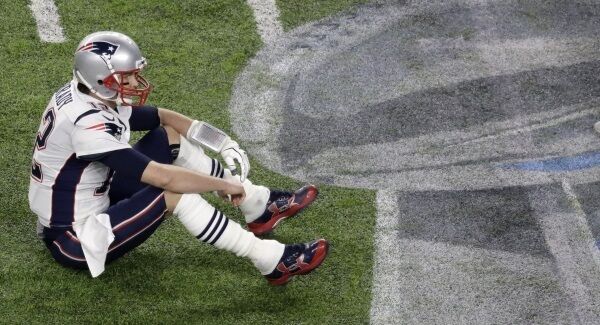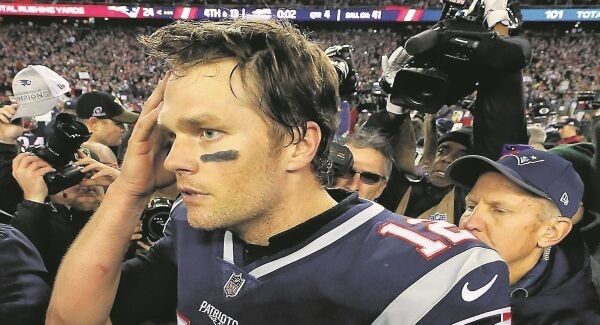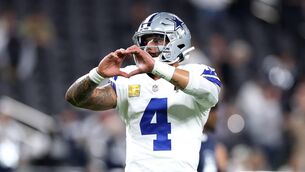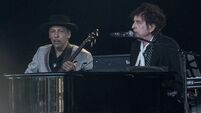Colin Sheridan: If Brady lands one last Hail Mary, it’ll be his greatest trick yet

In America, the quarterback has long been king.
The whiter, and more angular of jaw, the better.
The QB always gets the girl, doesn’t have to worry about his grades, and can count on Mama’s cooking to sustain his QB-ness.
The position has even been verbalised; to “quarterback” something is quasi-boardroom speak for taking charge, for developing a course of action.
It’s been said there is nothing more American than apple pie, well, there is: The quarterback.
And one quarterback in particular; Thomas Edward Patrick Brady Jr, he of the supermodel wife and supermodel children.
The greatest quarterback of them all, who last week left the New England Patriots — a sporting dynasty he led to six Superbowls in 20 years, leaving a legacy behind him as profound as it was once most unlikely.
Instead of retiring, Brady is heading south to Tampa Bay and $50m (€46m).
At 43 he looks more like an artist’s impression of a character in an old Frank Deford novel than a real person.
If one was to sepia-tint a photo of him, tie a soft-pink Ralph Lauren sweater around his shoulders, and put him in Hyannis Port, he’d look like a Kennedy.
But though he leaves his beloved Boston fanbase as the most decorated player in American Football history, his success was far from a lock, making his story even more remarkable.
At a glance, you’d think his path to greatness was sketched out by marketing executives and super agents; to listen to him — he possesses a rather Californian goofiness that belies his mastery on the gridiron — he neatly ticks all the boxes you’d expect from America’s QB.
But the truth is, he is an outlier.
To make it in the NFL — especially as a quarterback — the first thing you need in order to have a shot at ever taking a snap, is blue-chip prospect status.
Brady was a well-regarded prospect in his high school days in California, but nothing more.
At the University of Michigan, where the Wolverines regularly draw crowds of over 100,000 — he spent four years — the first two as backup, the second two as starter — and did… fine.
His now famous combine video shows him covering the 40-yard dash more like a malnourished Mayo wing-forward than a potential professional athlete.
Leaving Ann Arbor, he entered the 2000 draft “lightly regarded”.
In the end, there were 198 football players deemed better than Brady that year.
The New England Patriots drafted him days after the Commissioner, and all the cameras, had packed up to leave.

He went in the sixth round, at 199.
At that crossroads, a career on Wall Street was more likely than even a ‘good’ one in the NFL.
You could picture him at Merrill Lynch, where he interned during his college breaks, having a corner office, and a bespectacled secretary named Mrs Dembowski, who’d keep him straight.
At the watercooler the interns would whisper: “He was backup QB at Michigan — nearly got drafted!”
Those whispers would barely last until the next day’s trading bell, when the next backup QB stud would step out of the elevator.
He would’ve succeeded regardless. Maybe telling Mrs Dembowski to hold his calls the odd Friday afternoon.
Pouring himself a couple of fingers of 16-year-old Lagavulin, he might place his Ferragamo loafers on his office coach and allow himself a daydream; what might have been if some team, any team, had believed in him?
He may even close his eyes and hear the crowds roar his name from the bleachers.
In the end, there was no corner office, and no Mrs Dembowski.
There was, however, Bill Belichick, a man so monosyllabic he’d make Jim Gavin look like Kevin Keegan.
When Brady arrived in New England, Belichick was barely in the door himself.
That first season in 2000 was to be the coach’s only losing season to date.
In his second, the franchise won their first ever Superbowl, and Brady, the lightly-regarded prospect, was the star.
His role in that victory owes as much to serendipity as anything; an injury to the veteran starter Drew Bledsoe two games in opened the door.
After an iffy start, he found his stride. By the time the play-offs came around, the veteran Bledsoe was healthy and ready, if selected.
Belichick stuck with the lightweight California kid with the Irish name.
With the game on the line, Brady marched the Patriots down the field to victory, displaying an ice-cold game acumen that would go on to define his career.
Those who bothered to watch him in Michigan must’ve wondered, “that’s Tom Brady??”
Though he, Belichick, and team owner Robert Kraft went on to dominate as much as one can in a league where draft picks and salary caps restrict monopolies, the relationship between star player and coach never seemed to creep beyond mutual respect.
“I love your majesty,” said Cordelia to her father King Lear, “according to my bond: No more nor less”.

And so, it was with Brady and Belichick.
As Brady fought time, he relied more and more on his “wellness” coach Alex Guerrero, who, to you and me — and Belichick — is the type of guy you’d spot selling bottles of fresh air on a late-night infomercial, but to Brady became the fountain of his seemingly eternal youth.
The bond between coach and star was tested long before Brady left town last week, and the manner of his exit — though typically cordial — is testament that even the greats can’t write their endings.
Word on Newbury Street was Brady wanted to stay, but Belichick, and crucially Kraft, wanted him cut.
Belichick, like Alex Ferguson and Brian Cody, does not give his players farewell tours.
He has won Superbowls with donkeys and won them with thoroughbreds and will likely back himself to figure out how to do it without his storied No. 12.
Brady, having danced this dance with Belichick before, will have likely seen it coming.
So, he made his calls. He wrote his letters. He left.
“Go find another lover,” sang Bon Iver’s Justin Vernon, “to bring and string along”.
And so, Brady goes to Tampa. Somehow, a six-time Superbowl winner with a chip on his shoulder.
FOREVER A PATRIOT pic.twitter.com/QSBOJBs4uy
— Tom Brady (@TomBrady) March 17, 2020
He may not have the legs anymore, but then, he never did.
His arm may be weaker, but in football, and in game management, there are a myriad of ways around this.
One thing for certain, Brady has not gone to Tampa to take a knee and see out the clock, but to try win a Superbowl.
As the rest of us approach our 40s like Marie Antoinette the guillotine, Tom Brady at 43 will further elongate his pliable muscles, achieve his revenge body, and plot how to avenge the only man who wouldn’t love him; Belichick.
It will make fascinating viewing.
But the paradigm is shifting. Quarterbacks now, more than ever, move.
Patrick Mahomes and Russel Wilson are the new normal. They don’t look like Brady, and they don’t play like him either.
Mahomes and co play football as if it’s a high-brow talent contest. It’s all or nothing on any given Sunday.
They scramble and run and throw underarm on fourth down like Al Pacino is coaching them and Oliver Stone is directing.
Meanwhile, Brady watches, like Carlito Brigante just out of the joint, quipping: “Everybody dancing dances I don’t dance”.
He must know, in the battle of Tom v Time, the treacherous clock is soon to win.
It’s whether he can land one last Hail Mary.
If he does, it’ll be his greatest trick yet.















